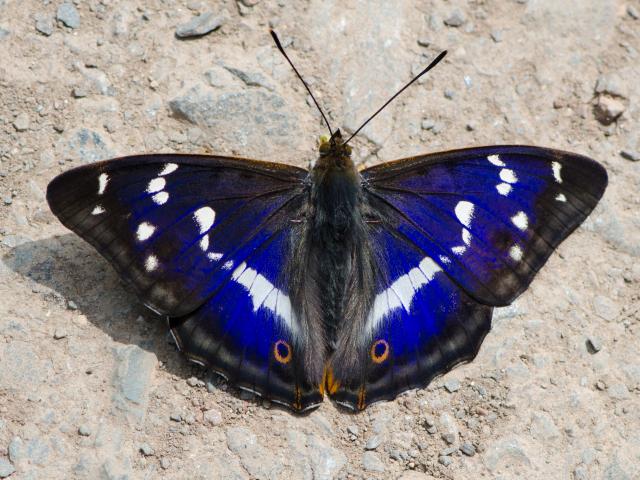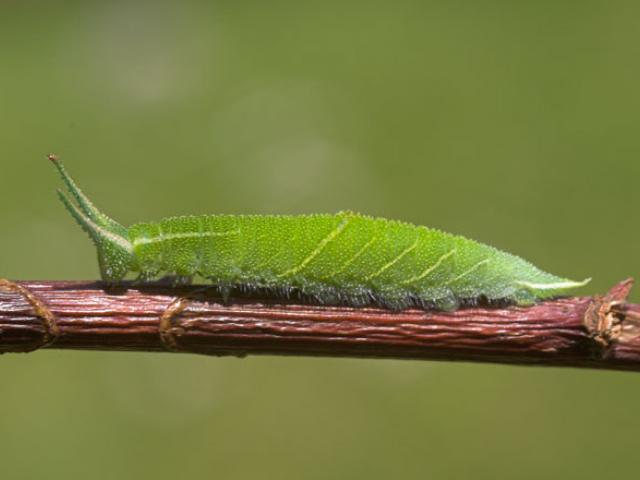I, like many others have been enthralled by the stories and adventures that usually accompany this magnificent butterfly and have experienced very happy memories of warm July days in search of this elusive royalty.
I have seen and photographed the Purple Emperor in Bentley Wood, one of its strongholds in the neighbouring county, Wiltshire. The history and the distribution of the Purple Emperor (Apatura Iris) in the county of Dorset, where I have grown up, has, however, been a story of scarcity and sporadic appearances. Nonetheless, in recent years the butterfly has graced us with its presence more frequently, raising the exciting possibility of a glorious return.
The earliest record that I have unearthed regarding this species in Dorset was published in Edward Newman's: British Butterflies & Moths 1880 (Page 76) where notes from J.C Dale reports the butterfly's occurrence in Woodland Wood, Near Hanford and lists Cranborne as a site but gives no date for his observations. It must, however, have been prior to 1872, the year of his death.
The butterfly was also seen during the 1880s, the only specific year given which I can find is 1889 (W. Parkinson Curtis) but no extensive data is given. After researching some general historic data, supplied by Butterfly Conservation, Dorset Branch, it is specified that the butterfly was once found in a particular broad-leaved woodland, named Bere Wood. The site, which still exists today, is situated close to the village of Bloxworth, an area I am quite familiar with and from my own observations, is still home to Silver-washed Fritillary and White Admiral. Despite a partial conversion to a Conifer plantation, the woodland has managed to maintain much of its former glory with many towering Oaks still intact.
The first of many gaps documented in the occurrence of this butterfly in Dorset arises with a nine-year period where no records, that I can find, are specified. In 1898 however, Ham Common, a site also surviving today, was noted as having seen a Purple Emperor (NBN Gateway) but once again, no further information was provided. The site, situated in the town of Poole, overlooks Poole Harbour and is primarily heathland habitat, interspersed with waste ground, mixed woodland and a medium freshwater lake. To any enthusiast that visits Ham Common today; one would not expect or even hope to expect his or her majesty to make an appearance. The remaining habitat is completely unsuitable to home the butterfly, for only scraps of the woodland remain, consisting mostly of young trees; Birch and a few Oak but Sallow continues to grow in semi-shade situations and to good sizes with a few impressive Poplars spread over the nearby holiday park.
There are no further records of this species until 1917, where Hooke Park and Alder Woods (NBN Gateway) are named, the latter site, which today covers approximately 329 hectares, comprises of 60 % Broad-leaved deciduous woodland. The site is still home to a small but stable colony of Marsh Fritillary; however, it has lost many species over the years, including the rare High Brown Fritillary (c1985). After 1917, there is a comment from the "Notes & views of the Purple Emperor" by Heslop, Hyde & Stockley 1964. On page 80 the occurrence of A. iris is mentioned at Middlemarsh Woods, stating that it was "observed as recently as 1927". There are still woodlands situated to the west of the village which are perhaps worth a search or at least in a nearby area for the Purple Emperor.
In 1929 there are further records between Bridport and Beaminster and another near Child Okeford in 1930. After this, the species was again listed at Alder Woods in 1939. It’s likely a colony persisted and was simply under-recorded at the time.

In the same year, a final record is provided from Ham Common, I have been unable to find any images or old maps of what the site looked like at the time of sightings but as already mentioned, in the 21st century, I imagine it looks very different. Following another 20 year gap, a single record from 1959 comes from a list of sightings from various years under the location “Dorset Heaths” but no date or specific location is provided.
During the 1960s, the Purple Emperor was reportedly sighted in a selection of different locations in Dorset, specifically: Castle Hill Wood in Cranborne, Bere Wood and other sites around Bloxworth and a list of unnamed locations close to Child Okeford, another near Studland and Hanford.
Following this long period of intermittent records, the 1970s provide some increasingly detailed records, largely thanks to the work carried out by Margaret Brooks and Jeremy Thomas. A colony was observed and studied by Brooks and Thomas in the Cranborne Chase woodlands during the years 1973 and 1978 with the butterfly being recorded singly, the majority between the villages of Horton and Cranborne in 1970, 1974 (26 July), 1975 and 1979. Localities were it was also observed, briefly on some occasions include Manswood, Woodcutts and Scrubbity Barrows, Holt Forest, the Horton area, Woodlands Park and one slightly west of Powerstock.
The sightings continue into the 1980s, in the years: 1980, 82, 84, 85, 87, 88 (8 June), 89 (26 May). Brooks and Thomas reported it from Cranborne Chase woodlands, close to the Wiltshire border during the '80s but were also intermittently noted in the areas between Cranborne and Wimborne Minster, including Castle Hill Woods, Woodlands, and Holt forest and again at Horton and Manswood. The RSPB additionally state a single sighting from Garston Wood during the same period.
The 1990s certainly appear to be a decade of extreme scarcity and slightly puzzling sightings, the first from Stalbridge Park, near the A30 in 1991 and Langton West Woods in the Purbeck and south of Corfe. In 1996 there were two sightings from an undisclosed site in Dorset, one on 26th July and another on 5th August, the next year at least one was recorded on 14th July, referring to that from Stalbridge Park, a location with a small woodland nearby.
In 1998, two single records were provided from St Aldhelm’s Head (possibly referring to Langton Westwood) on the 18th and 25th July, perhaps of the same butterfly. The limestone headland site which sits close to Worth Matravers is on the south coast of Dorset where a few, small strips of woodland lie between the chalk grassland and farmland but it’s possible that these were both of a released or escapee specimen.

Between the years 2000 and 2005, the only sighting of this butterfly in Dorset that I can find comes from 20th July 2000 at an unnamed location.
In 2005, a five-year survey, of the most likely Purple Emperor sites in Dorset was launched by Roger Smith and a team of volunteers to try and uncover the species again. The butterfly was successfully recorded in July 2005 at Bere Wood which was the same site that previously recorded the butterfly in the 1880s, 1960s and lastly in the 1970s.
Between the years 2005 and 2010, the following possible records have been noted, some from members of the public: 11th, 14th and 15th of July 2006, 16th, 17th and 21st July 2008, 28th June 2009 – One seen by Peter Davey at Rooksmoor during the late morning, a glimpse before flying into the canopy. The site which lacks any large clearings is situated adjacent to Butterfly Conservation's Alners Gorse reserve.
Then in July 2010, the tale of the Purple Emperor in Dorset took an exciting turn with a sudden increase in sightings and a small colony discovered by Steven Andrew’s who discovered & photographed the first one in Cranborne Chase Woods in July 2010, just 2km away from where it was studied by Brooks and Thomas in the 1970s.
The location, at which another sighting was noted just a few days later by Bill Shreeves and Roger Smith, is based largely on a chalk plateau, covering 380 square miles.
Following on from this discovery, there were singular sightings from Deadmoor Common (17th July) on the Minterne Estate with adjoining woodland near Dorchester in 2011 (15th July), 2012 (26th & 30th July) and 2013. Another was seen on the 8th August 2013 in Alderholt.
In 2014, three records from North Dorset, on the 5th July 1 male was photographed in Cranborne Chase Woodlands near Sixpenny Handley that runs continuously at the top of Cranborne Chase and close to the border of Wiltshire, where the species has conserved a stronghold. Seen again on the 10th July and another, probably the same butterfly on 12th July.
Interestingly, it appears when visiting these sites that there is a distinct lack of the Emperors primary foodplant; Goat Willow (Salix cuprea) when compared with the presence of Grey Sallow (S. cinerea) and Crack Willow (S. fragilis) but more detailed searches are needed and will be carried out by Dorset Branch members. Records of butterflies being seen towards ground level in Dorset were relatively few until recent years. Despite this increase, no immature stages of the butterfly have been found since the 1970s, to confirm a breeding colony.

In conclusion, the Purple Emperor has indeed, been recorded in Dorset for at least the past 140 years but in my opinion, was very likely found here long before that, from recent reports by Butterfly Conservation’s Dorset branch it seems that there are two viable populations of the butterfly in Dorset, one within the woodlands of Cranborne Chase, stretching along this area and another in or near Minterne Magna. It's likely that a third colony survives in small numbers in the area surrounding Horton, Cranborne and Alderholt in addition to a possible fourth in the Rooksmoor and Deadmoor woodlands.
We are at an exciting period where evidence is building as to the locations of this butterfly and potential colonies in Dorset; nevertheless, more work definitely needs to be done to locate the site at which these butterflies are breeding.
Andrew Cooper
Follow Andrew on twitter - @AndrewCooperBC
References
- Joint Nature Conservation Committee (JNCC), © Crown copyright 2011 [Accessed, March 2015] http://ow.ly/Kxv5K
- Shreeves, B., Steele, C., Surrey, R., Thomas, J. (1998) New Atlas of Dorset Butterflies. Dorset: Dorset Natural History and Archaeological Society
- Thomas, J. and Webb, N. (1984) Butterflies of Dorset. Dorset: Dorset Natural History and Archaeological Society
- Newman, E. (1880) The Illustrated Natural History of British Butterflies and Moths
- -------. (2007) -----------------------.Butterfly Conservation, Dorset Branch Newsletter (no. 56)
- -------. (2009) -----------------------. Butterfly Conservation, Dorset Branch Newsletter (no. 62)
- NBN Gateway (n.d.) Apatura iris (Linnaeus, 1758) [Purple Emperor] [Online]. Available from http://bit.ly/1EScQ4t [Accessed March 2015]
- Smith, R. (2014) The Purple Emperor in Dorset: a chronology and update. Butterfly Conservation, Dorset Branch Newsletter (no. 75)


